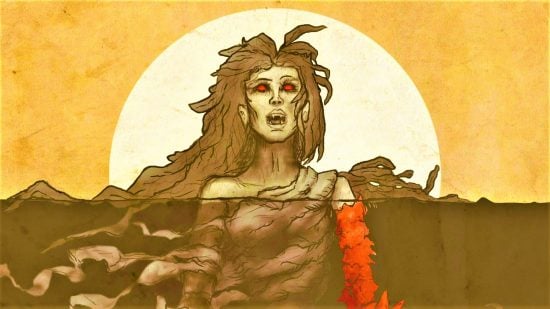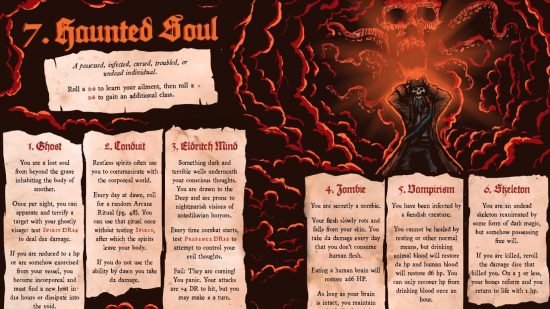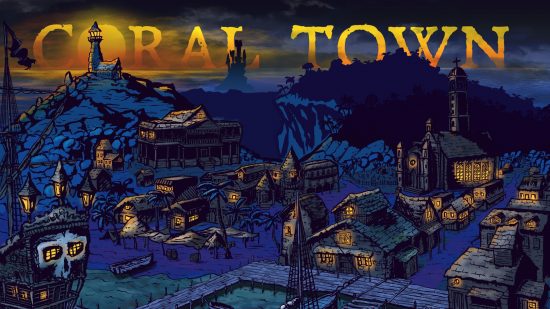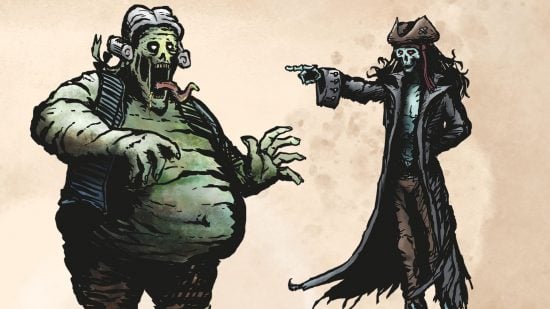Our Verdict
While a more complex, campaign-friendly version of Mörk Borg will shiver many timbers, for us it sailed too far from the system it was based on. A bit more fine-tuning could have made this a real treasure.
On paper, Pirate Borg sounds like a perfect match. The swashbuckling adventures of the high seas were ripe for a grotty, grim adaptation, and what better tabletop RPG to provide than the grisly OSR system Mörk Borg provides? Free League Publishing’s latest Borg book offers plenty of meat for the aspiring buccaneer to chew on – but it’s not quite the treasure haul we were hoping for.
Before setting sail on this Pirate Borg review, let’s chart a course. Firstly, we want to mention our copy of Pirate Borg was generously provided by Free League. It’s also worth noting our opinions are based on a full readthrough but fairly limited playtesting (we’ve still got a lot of plundering to do). With that all mapped out, let’s get into the crests and troughs of Pirate Borg.
What is Pirate Borg?
Pirate Borg is an adaptation of the grim, rules-light tabletop RPG Mörk Borg. It comes from designer Luke Stratton (with the occasional slithers of content from guest creators, among which is Mörk Borg creator Pelle Nilsson).
Mörk Borg transformed traditional fantasy concepts into a whimsically ghoulish new form, and Pirate Borg now attempts to do the same for a sea-faring setting. It’s set in a dark, supernatural version of the real world during the Golden Age of Piracy, with authentic pirate locales and genuine historical entities making a cameo (everyone wave to the West India Company).
What’s in Pirate Borg?
Pirate Borg keeps the bare bones of Mörk Borg as they were, but it adds a significant amount of new rules and features. It also offers 31 pages of pre-written adventure content – that’s more than the adventures of Mörk Borg and Cy_Borg combined.
New Pirate Borg rules
Pirate Borg immediately shakes up the ship by adding a new stat to character creation. ‘Spirit’ replaces Presence as the go-to spellcasting stat, and it also represents your character’s willpower.
Most other changes focus on expanding the system, too. There are heaps more randomized tables for relevant (and pleasing) features like drinking, singing pirate shanties, and creating treasure maps.
Pirate Borg offers eight new classes with unique character progression features. Six of these classes align very closely with your standard DnD classes – you’ve essentially got a simplified Barbarian, Rogue, Ranger, Fighter, Cleric, and Sorcerer to choose from. The remaining two are a little more original, allowing you to play as supernatural creatures often found at sea or on deck.
Skill checks and combat still use a very simple d20 system, but Pirate Borg adds further complexity with the introduction of naval combat. This isn’t too crunchy once you wrap your head around it, but it does require you to track ships on a hex grid rather than leave everything to imagination.
Pirate Borg adventure
The pre-written Pirate Borg adventure gives you the run of an entire tropical island. Black Coral Bay offers plenty of plunder and mysteries, as well as a curse that’s stopping the dead from staying particularly dead.
Pirate Borg openly declares its target audience for the book’s pre-written adventure – experienced GMs. There’s no clear goal or plot to tie the various dungeons, locations, and characters together; Pirate Borg instead offers a sandbox filled with materials to be organised and written around as GMs see fit. It’s a perfectly serviceable pirate adventure, filled with supernatural beasts and mysterious temples, as long as you’re prepared to do a bit more homework.
Is Pirate Borg good or bad?
Pirate Borg makes the system it’s based on significantly less rules-light, which offers mixed success. On one hand, it makes the system more campaign-friendly, keeping the novelty of a Borg game going for longer with an extended adventure and new class features to unlock. However, in doing so, it keelhauls a lot of what made Mörk Borg special in the first place.
We love Mörk Borg for its simplicity. It often chooses style over substance, but this makes games feel flexible rather than shallow. Its gorgeous visuals and wonderfully weird flavor are as much of a pull as the gameplay itself, and it’s easy to set up a meat grinder of a game quickly.
In expanding the game to make room for extra rules and real-world history, Pirate Borg loses a lot of Mörk Borg’s identity. It’s definitely ‘Pirate’, but it’s not very ‘Borg’.
This doesn’t mean the game’s a total shipwreck – Pirate Borg pirates pretty darn well, in fact. It offers a setting with plenty to explore and a strong sense of dark humor. Yes, there’s some kind of undead apocalypse on the horizon, but it’s hard to be frightened when the entire crew is drunk on grog.
From our limited gameplay tests, the new rules all seem successful and enjoyable to use. The monsters in Pirate Borg’s bestiary create varied combat scenarios, and there are enough variables to manage in naval combat for these to be made exciting, too.
Pirate Borg is peppered with great ideas, but its success is inconsistent at times. And sadly, the game feels a lot less polished than its siblings.
The art of Pirate Borg (a mix of original illustrations from Limithron and public domain images) doesn’t shine the way Johan Nohr’s does in Cy_Borg and Mörk Borg. Additionally, the book regularly abandons beautiful page design in favor of basic layouts that prioritize space and clarity. Normally looks aren’t high on our list of concerns for a TTRPG, but the Borg games have a reputation as glossy coffee-table-worthy works of art, so this book is subject to higher-than-usual levels of scrutiny.
The writing also suffers from a lack of clarity and consistency at times. On a purely surface level, you should expect to see some grammar and spelling mistakes throughout (we’re still not sure if the adventure is called ‘Curse at Skeleton Point’ or ‘Curse of Skeleton Point’).
More substantially, there were several instances where we weren’t exactly sure how things worked. Character creation, naval combat, and the adventure’s random encounters could all have gone smoother with more precise wording and instruction.
This book has tried to make the mighty ship Borg bigger and more impressive than ever before. The new sections have cracks and leaks, but overall it’s pretty sea-worthy. Just don’t expect the galleon to be quite as shiny as before.








